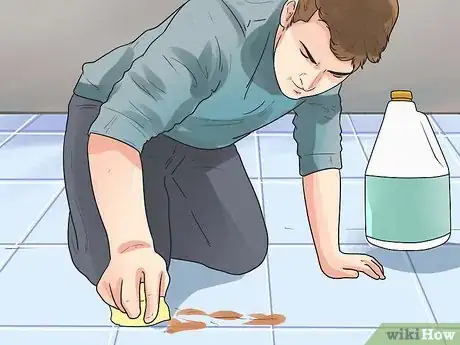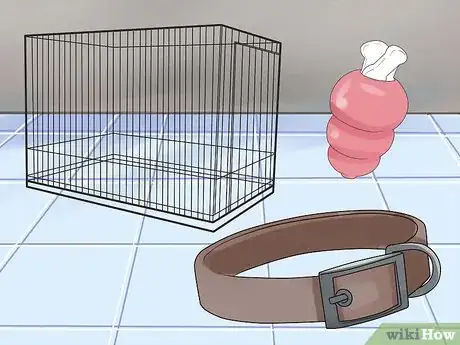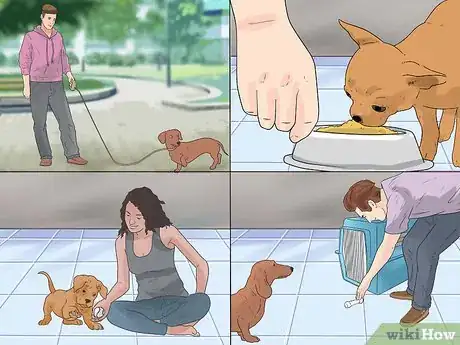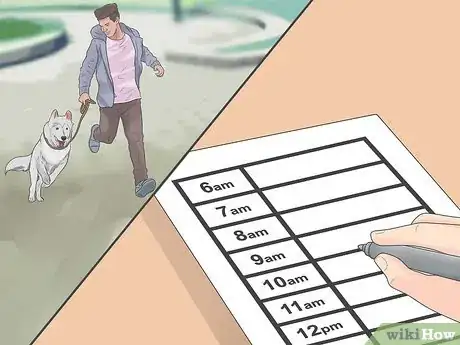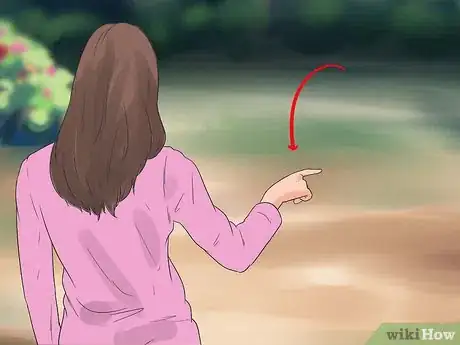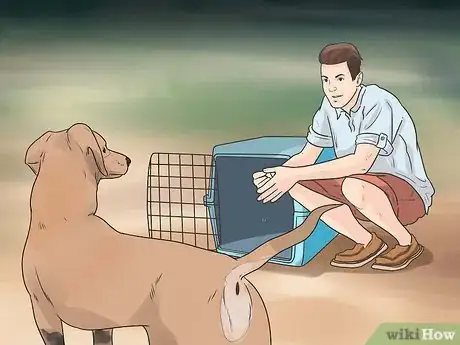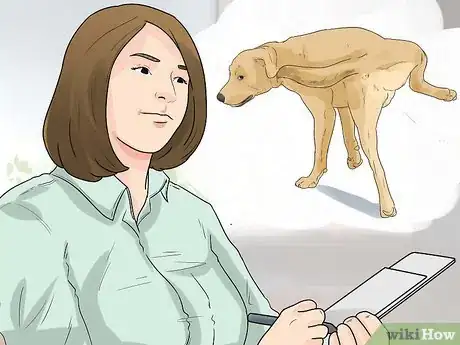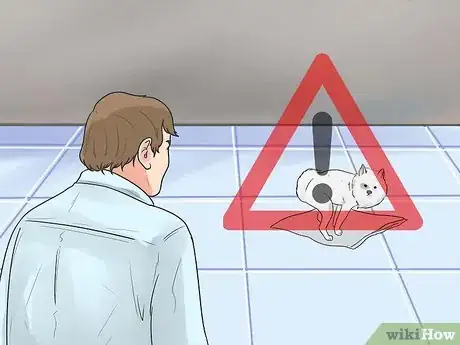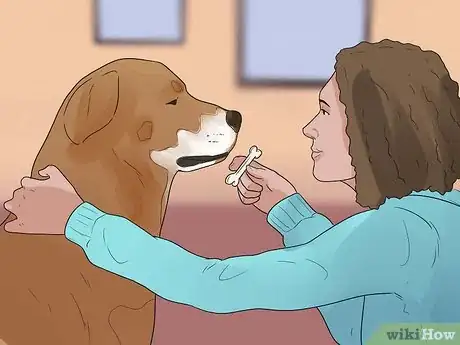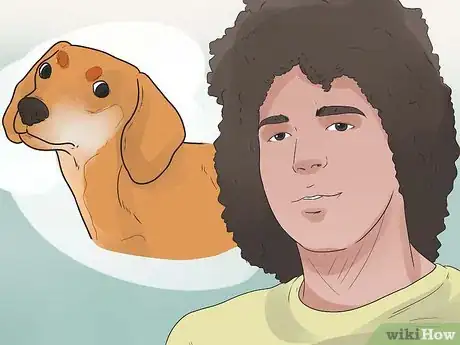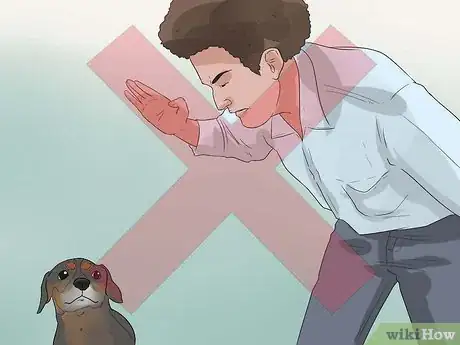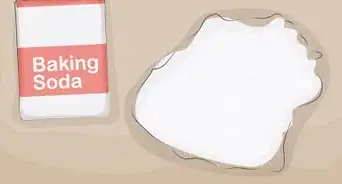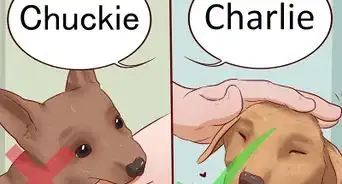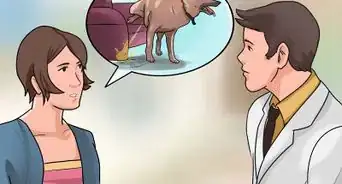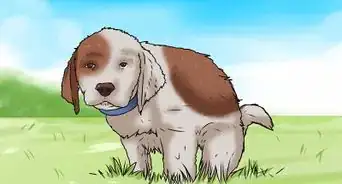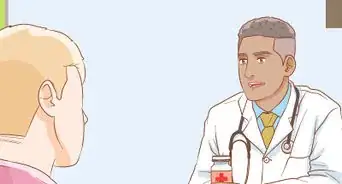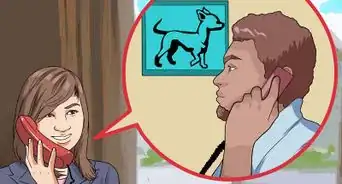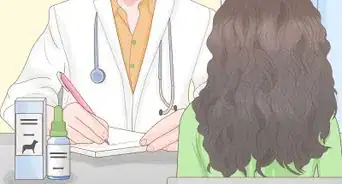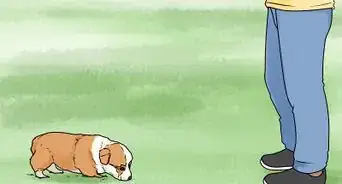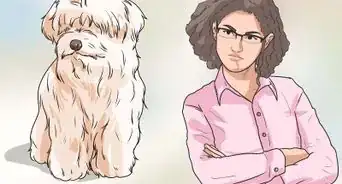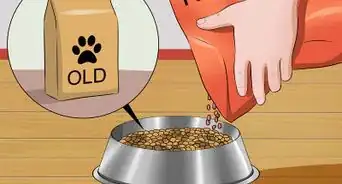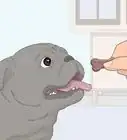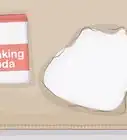This article was co-authored by David Levin. David Levin is the Owner of Citizen Hound, a professional dog walking business based in the San Francisco Bay Area. With over 9 years of professional dog walking and training experience, David's business has been voted the "Best Dog Walker SF" by Beast of the Bay for 2019, 2018, and 2017. Citizen Hound has also been ranked #1 Dog Walker by the SF Examiner and A-List in 2017, 2016, 2015. Citizen Hound prides themselves on their customer service, care, skill, and reputation.
wikiHow marks an article as reader-approved once it receives enough positive feedback. In this case, 96% of readers who voted found the article helpful, earning it our reader-approved status.
This article has been viewed 220,898 times.
Depending on your dog, your family, and your lifestyle, house training a dog can be anywhere from easy to almost impossible. It can work to house train your dog quickly so that you can move past this difficult stage of owning a dog. It takes planning, dedication, and patience, but your dog can get house trained in a short amount of time.
Steps
Preparing to House Train Your Dog
-
1Get rid of residual odors in your home. Before you start your house training plan, you need to ensure that your home is free from urine stains and residual odors. Once you’ve gotten rid of any odors and stains, your dog will not be attracted to certain areas of the house to use as a potty.
- Purchase a black light and a pet odor remover from your local pet store. When it is dark, turn off all the lights and thoroughly inspect your home, floors and/or carpets, and furniture. The black light will reveal any old stains so you can effectively clean and remove them. There are many effective pet stain/odor cleaning products available on the market.
-
2Assemble your supplies. Having your supplies on hand will make it easier for you to focus on house training your dog without needing to run to the store. Gather the following supplies:
- Wire crate: Get a good quality wire crate that is large enough for your dog to stand up, lie down and turn around in. Position the crate in a quiet (but not isolated) part of your home.
- Collar and leash
- Chew toys and squeaky toys
Advertisement -
3Arrange for help if you aren’t home during the day. In order to get your dog house trained in 10 days, you need to follow a strict schedule of potty breaks, meals, playtime, and crate confinement. If you can’t come home for certain parts of the day, then arrange a dog walker or pet sitter to visit your house to take care of the midday break.
Following a Consistent Routine
-
1Follow a 24-hour schedule. In order to house train your dog in 10 days, you need to strictly follow a schedule. This will establish a routine for both you and your dog. Your dog needs to go out first thing in the morning, after meals and play times, and before bedtime. Every moment should be accounted for. This is a sample schedule for someone who is home all day:
- 7:00 a.m.: Wake up and take the dog outside.
- 7:10-7:30 a.m.: Free time in the kitchen
- 7:30 a.m.: Food and water
- 8:00 a.m.: Go out
- 8:15 a.m.: Free time in the kitchen
- 8:45 a.m.: Crate confinement
- 12:00 p.m.: Food and water
- 12:30 p.m.: Go out
- 12:45 p.m.: Free time in the kitchen
- 1:15 p.m.: Crate confinement
- 5:00 p.m.: Food and water
- 5:30 p.m.: Go out
- 6:15 p.m.: Crate confinement
- 8:00 p.m.: Water
- 8:15 p.m.: Go out
- 8:30 p.m.: Free time in the kitchen
- 9:00 p.m.: Crate confinement
- 11:00 p.m.: Go out and crate confinement overnight
-
2Choose a designated spot for toileting. Select a place in your backyard that is suitable for your dog’s toileting. The base of a tree or a green patch of grass is ideal. Use this spot every time you take your dog to the potty.
- At a scheduled potty time, or when you recognize your dog’s cues for needing to relieve himself, take him outside to this spot.
- Use consistent language to refer to this place. For example, when your dog reaches this spot, say, “Go potty,” or use a similar verbal cue. Then your dog will associate this spot with toileting.
- Be sure to follow your city’s ordinances with regards to pet waste removal. If you are in a city and don’t have a good green space for your dog to toilet, make sure you have plastic bags to pick up the waste.
- If you live in a small space, such as a high rise apartment, you might need to use a dog litter tray in your apartment. This will give your dog a place to go inside.
-
3Make the dog’s crate a safe place. Your dog will stay in his crate for a few hours during the day, as well as overnight. Dogs like to have a small “den” to sleep in. A crate is a good place for the dog to feel safe. Make the crate comfortable, with a blanket, chew toys and squeaky toys.
- Don’t use the crate as a punishment. Otherwise, your dog will associate this place with fear or anxiety rather than safety and comfort.
-
4Learn your dog’s signs. Pay close attention to your dog so that you learn when he has to go. This might include the dog walking around stiffly or in circles, sniffing the floor like he’s searching for somewhere to pee, or letting his tail rest in a strange position.
- If your dog looks like he needs to relieve himself, take him out to his designated spot right away. Do this even if you’re not at your scheduled potty break.[1]
-
5Keep track of your dog’s habits. Write down your dog’s eating schedule and bathroom habits. Note when your dog urinates and defecates. Note the exact time your dog eats and any other treats it is given during the day. Your journal will help you determine how long after eating and drinking your dog typically needs to relieve himself. You can use this information to adjust your schedule if necessary.
-
6Keep a close eye on your dog at all times. You need to keep a vigilant eye on your dog whenever he is out of his crate. Even if he’s in the kitchen during his free time, you still need to watch him. This will ensure that you catch him before he has an accident. It’s imperative during this time that your dog associates toileting with going outside.
- You might consider tethering your dog to your waist with a leash when he is out of his crate.[2] This way, you will be sure to keep him very close to you. You can track his movements more closely.
-
7Clean up messes immediately. If your dog has an accident in the house, clean it up as soon as possible. You don’t want your dog associating relieving himself with being inside the house.
Giving Praise to Your Dog
-
1Give lots of praise. When your dog has relieved himself outdoors, give him lots of attention and pats. Say, “Good dog!” and other praise. Have a little celebration with your dog. This lets your dog know that its behavior is remarkable and deserves praise.
-
2Make sure to time your praise appropriately. When your dog has finished relieving himself, give him praise right away. You want to be sure that he associates the praise with the action that he just did. Otherwise, he might get confused about what he’s being praised for.
-
3Keep your voice friendly. Don’t use a harsh tone with your dog while you’re house training him. You don’t want him to feel scared or anxious about going outside or relieving himself.
- Don’t yell at your dog if he has an accident indoors.
-
4Don’t punish your dog for accidents.[5] Your dog is learning how to follow your instructions. Be patient with him. Don’t rub his face in his waste.[6] Don’t yell or shout at your dog. Don’t hit your dog. If you’re not patient and friendly, your dog may associate fear and punishment with toileting.
- If you catch your dog in the middle of an accident, make a loud noise or clap to startle him. Then he will stop urinating or defecating, and you can take him outside to finish up.
Expert Q&A
-
QuestionHow can I potty train my dog fast?
 David LevinDavid Levin is the Owner of Citizen Hound, a professional dog walking business based in the San Francisco Bay Area. With over 9 years of professional dog walking and training experience, David's business has been voted the "Best Dog Walker SF" by Beast of the Bay for 2019, 2018, and 2017. Citizen Hound has also been ranked #1 Dog Walker by the SF Examiner and A-List in 2017, 2016, 2015. Citizen Hound prides themselves on their customer service, care, skill, and reputation.
David LevinDavid Levin is the Owner of Citizen Hound, a professional dog walking business based in the San Francisco Bay Area. With over 9 years of professional dog walking and training experience, David's business has been voted the "Best Dog Walker SF" by Beast of the Bay for 2019, 2018, and 2017. Citizen Hound has also been ranked #1 Dog Walker by the SF Examiner and A-List in 2017, 2016, 2015. Citizen Hound prides themselves on their customer service, care, skill, and reputation.
Professional Dog Trainer Try keeping your dog on a leash near you at all times. Pay attention to when your dog shows signs that it needs to go so you can take it outside.
Try keeping your dog on a leash near you at all times. Pay attention to when your dog shows signs that it needs to go so you can take it outside. -
QuestionCan I start training my 8-week-old puppy to toilet outside?
 Pippa Elliott, MRCVSDr. Elliott, BVMS, MRCVS is a veterinarian with over 30 years of experience in veterinary surgery and companion animal practice. She graduated from the University of Glasgow in 1987 with a degree in veterinary medicine and surgery. She has worked at the same animal clinic in her hometown for over 20 years.
Pippa Elliott, MRCVSDr. Elliott, BVMS, MRCVS is a veterinarian with over 30 years of experience in veterinary surgery and companion animal practice. She graduated from the University of Glasgow in 1987 with a degree in veterinary medicine and surgery. She has worked at the same animal clinic in her hometown for over 20 years.
Veterinarian Absolutely! 8 weeks is the ideal to start training, although he's a little young to get the hang of things so be prepared for 'accidents.' Just be sure to be encouraging when he does toilet outside, so he realizes this is a good thing (rather than telling him off for going indoors).
Absolutely! 8 weeks is the ideal to start training, although he's a little young to get the hang of things so be prepared for 'accidents.' Just be sure to be encouraging when he does toilet outside, so he realizes this is a good thing (rather than telling him off for going indoors). -
Question7-week-old puppy isn't eliminating on the paper that I want him to use as a toilet. What can I do?
 Pippa Elliott, MRCVSDr. Elliott, BVMS, MRCVS is a veterinarian with over 30 years of experience in veterinary surgery and companion animal practice. She graduated from the University of Glasgow in 1987 with a degree in veterinary medicine and surgery. She has worked at the same animal clinic in her hometown for over 20 years.
Pippa Elliott, MRCVSDr. Elliott, BVMS, MRCVS is a veterinarian with over 30 years of experience in veterinary surgery and companion animal practice. She graduated from the University of Glasgow in 1987 with a degree in veterinary medicine and surgery. She has worked at the same animal clinic in her hometown for over 20 years.
Veterinarian A 7-week-old puppy is very young, and likely to be going to the toilet as and when the urge takes him. Most puppies only start to understand toilet training from 8 weeks. In the meantime, spread paper over the entirety of the balcony, and praise him when he uses the paper. As he gets older and is regularly visiting the balcony, gradually decrease the area covered with paper. Be sure to praise him when he chooses paper over the floor.
A 7-week-old puppy is very young, and likely to be going to the toilet as and when the urge takes him. Most puppies only start to understand toilet training from 8 weeks. In the meantime, spread paper over the entirety of the balcony, and praise him when he uses the paper. As he gets older and is regularly visiting the balcony, gradually decrease the area covered with paper. Be sure to praise him when he chooses paper over the floor.
Warnings
- If house training is not working for your dog, you may need to identify issues that are preventing him from being housebroken. For instance, certain medical conditions make house training difficult.[8] Check with your vet if you have concerns about your dog.⧼thumbs_response⧽
References
- ↑ http://www.humanesociety.org/animals/dogs/tips/housetraining_puppies.html
- ↑ David Levin. Professional Dog Walker & Trainer. Expert Interview. 19 December 2019.
- ↑ David Levin. Professional Dog Walker & Trainer. Expert Interview. 19 December 2019.
- ↑ https://www.aspca.org/pet-care/virtual-pet-behaviorist/dog-behavior/house-training-your-puppy
- ↑ David Levin. Professional Dog Walker & Trainer. Expert Interview. 19 December 2019.
- ↑ https://www.aspca.org/pet-care/virtual-pet-behaviorist/dog-behavior/house-training-your-puppy
- ↑ https://www.aspca.org/pet-care/virtual-pet-behaviorist/dog-behavior/house-training-your-puppy
- ↑ http://pets.webmd.com/dogs/guide/house-training-adult-dogs
About This Article
To house train your dog quickly, start by picking a spot in your yard for your dog to go potty, like the base of a tree. Then, take your dog to that spot first thing in the morning, after meals and play times, and before bedtime every day. Once you’re at the spot, say “Go potty” so it associates the area with toileting. Additionally, keep track of your dog’s potty habits, then tweak the schedule to take your dog out when it usually needs to go. You should also watch for other signs that your dog needs to go, like walking around in circles or sniffing the floor like it’s searching for somewhere to pee. For more tips from our Veterinary co-author, like how to use praise and encouragement to help train your dog, read on!
